- This article is part four of similar articles, the first three being on Punjab, Maharashtra and Rajasthan.
Lush green fields, bustling rivers, spectacular white sandy beaches with pristine blue waters, dreamy houseboats that sail in the backwaters, and an abundance of flora and fauna in expansive marshlands - all the factors that contribute to the epithet for Kerala: ‘God’s Own Country.’
Despite being an ancient land,
Kerala is one of the most socially and pedagogically progressive states in
India. The people of Kerala: the Malayalis, value their time-honoured arts and traditions.
They live a modern lifestyle classically intertwined with a traditional approach.
Here is an attempt to extol the arts, crafts, dance, literature, and ayurvedic traditions
of Kerala.
1. Arts
& Crafts of Kerala
Kerala is a paradise for the connoisseurs of aesthetics. Its centuries’- old art and craft forms have enthralled millions of visitors.
1. Paintings
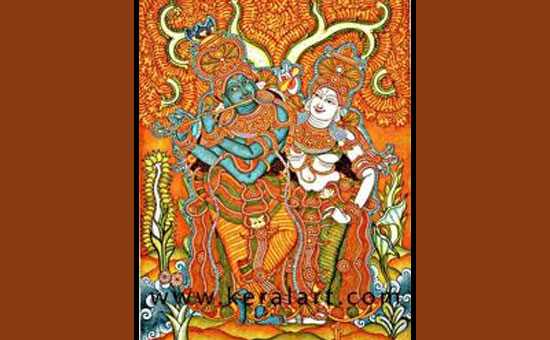 A painting from Kerala.
A painting from Kerala.
Kerala boasts of a unique style of paintings. Floor drawings and paintings in the state are traditionally called ‘Kalamezuthu.’ Kerala is known for its oil paintings on canvas, among these are the beautiful paintings by Raja Ravi Varma, the greatest artist from Kerala. Frescos depicting scenes from local traditions and epics are seen on the walls of temples. Many temple walls are adorned with centuries-old murals that are well-preserved.
2. Handicrafts
Handicrafts in Kerala range from
brass and metal works, wall hangings, coconut shell products, and gold and
silver jewellery. All these products are artistically embellished by skilled
craftsmen.
a. Brass
and Metal works
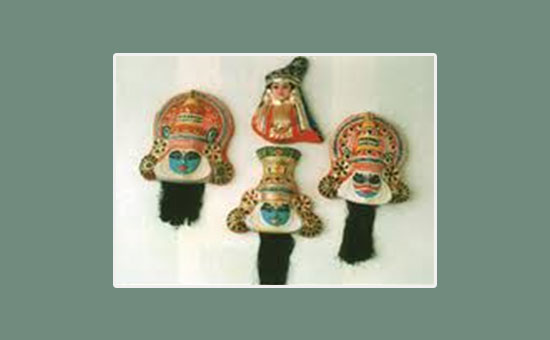 Metal works from Kerala.
Metal works from Kerala.
Bell metal - an alloy of tin, copper and brass is moulded into distinct shapes and sizes to create idols that depict characters and events. One specific event depicted in bell metal is the Tandava Dance. One can also find several household articles and lamps made of bell metal on display in local markets.
b. Coir
and cane products
The cottage industry in Kerala
boasts of manufacturing coir products. Several household objects such as mats,
mattresses, floor furnishings and so on are made of coir and cane. Furniture
made of cane finds many buyers and is shipped across the country.
c. Sandalwood
carvings
The districts of Cochin, Trichur,
Tiruvananthapuram, and Ernakulam are famous for articles made of sandalwood. Decor
pieces and souvenirs such as jewellery boxes, pen cases, wall hangings, wind
chimes, ashtrays, toys, candle stands, miniature models of animals and so on
made of sandalwood are seen in local markets and at all tourist destinations
across the state.
2.
Dances of Kerala
Performing arts in Kerala
comprise dance, music, and theatre. Kerala features classical dances such as
Kathakali, Mohiniattam, Pulikali as well as ritualistic form dances like Theyyam,
Kummathikkali and Mudiyettu. Read on about the glorious dances.
Folk
Dances
a. Kathakali
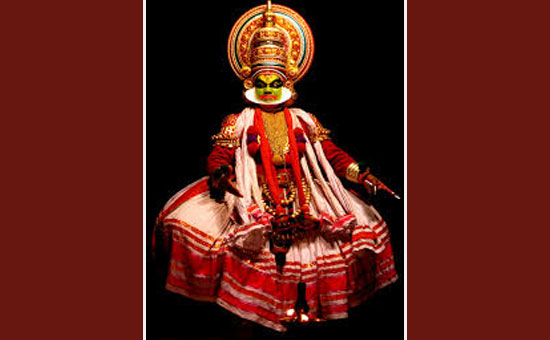 A Kathakali dancer.
A Kathakali dancer.
Kathakali, the classical dance
form of Kerala is renowned for its elaborate and heavy make-up, costumes,
masks, and ornaments. It dates back to the 17th century and presents stories
from the Ramayana and Mahabharata.
Mahakavi Vallathol Narayan Menon
is known to have given Kathakali its present form by establishing the Kerala
Kalamandalam, an institution to train people in classical dance forms. Earlier
these dance forms were staged only in temples. Vallathol played a major role in
bringing them out of the four walls of temples and providing opportunities for others
(communities and religions) to witness this art form.
Kathakali consists of both nritya
(pure dance) and abhinaya (mime). It uses the entire body, including the facial
muscles, to depict emotion. Earlier it was performed only by men, but women are
increasingly taking to this dramatic dance form.
The characters in Kathakali are Pacha (green-Satwika-heroes), Kari (black-villains)and Minukku (female). Characters don either a white or a red beard - Hanuman and the sages wear a white beard, while Baali is seen sporting a red beard. Kathi (means knife) is another category of villain. The dancer uses his/her interpretation to portray the story that is sung for them, making the dance form one of the most magnificent theatres of imagination and creativity.
b. Mohiniattam
 A Mohiniattam dancer.
A Mohiniattam dancer.
Mohiniattam originated in the
state of Kerala. It is a solo female dance performance performed by gently
swaying the body from side to side. The theme of Mohiniattam is rooted in the
feminine concepts of shringara and
love. It is believed that Mohiniattam is devoted to the feminine form of Vishnu:
Mohini - the enchantress.
The guidelines for hand and arm movements in this dance form are mentioned in the classical text called ‘Hastha Lakshandeepika.’
Mohiniattam gradually gained a
tainted reputation as the Devdasi system took root in Southern India. However,
with social reform and ethical consciousness, the dance form eventually
regained its past glory and respect.
In the 19th century, the enlightened ruler of Travancore, Swati Tirunal revived the dance form and encouraged performances with the accompaniment of musical instruments such as the violin, veena, and mridangam. He composed approximately 50 padams (verses) replete with scope for abhinaya.
c. Pulikali
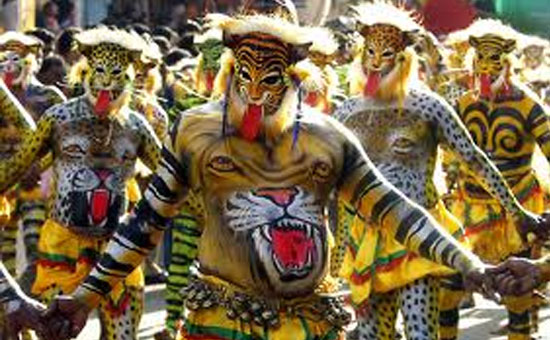 Pulikali performance.
Pulikali performance.
Pulikali, also known as Kaduvakali is a traditional folk dance-form of Kerala, most popular in the regions of Palakkad and Thrissur. In Malayalam, Pulikali lierally means ‘play of the tigers.’ It was introduced by Sakthan Thampuran about two centuries ago.
Pulikali is performed on the
fourth day of Onam. The performers of Pulikali, usually six in a group, have
their bodies painted in colours and patterns that represent the tiger, wear
tiger masks, and perform a dance which resembles the hunting rituals performed
while on a tiger hunt.
The dance comprises scenes such
as the tiger catching its prey (offered as bait by the hunters) and crescendo
where the tiger is finally caught by the hunters. The drummer plays a very
important part of this act as the beat, rhythm, tempo, and vibrations are
provided by the drums.
To
see 5 pictures of Pulikali dance at Thrissur
Ritual
dances
a. Theyyam
 Theyyam performance.
Theyyam performance.
Theyyam, a ritual dance-form performed by a certain community of Kolathunadu area of Kerala dates back several thousand years. The dance is performed by a dancer referred to as Theyyam (corrupt form of deivam means God). People of neighbouring districts revere Theyyam as one would revere God himself, and seek his blessings.
Theyyam is first performed without make-up and called Vellaattam. Then with make-up. The performer makes a parikrama of the Temple or the grove in the ancestral home, then he runs in the courtyard and blesses the family members. Musical instruments, dance steps, vocal recitations, peculiar makeup, and costumes – make Theyyam a visual treat.
b. Mudiyettu
 A Mudiyettu performance.
A Mudiyettu performance.
This traditional ritual dance-form
is performed to enact the event of Goddess Kali killing the demon Darika. This
ritual belongs to the Bhadrakali cult prevalent in some parts of Kerala.
Kuruppanmar, a certain set of
people, perform this ritual dance in temples called Bhagvati Kavus. These temples are dedicated to the Mother Goddess.
3. Martial
Arts & Sports of Kerala
The Malayalis believe in holistic
development of the body, mind, and soul, and train in martial arts starting
right from early childhood. Martials arts are teamed with rowing competitions
which take place during festivals such as Onam and Vishu.
a. Kalaripayattu
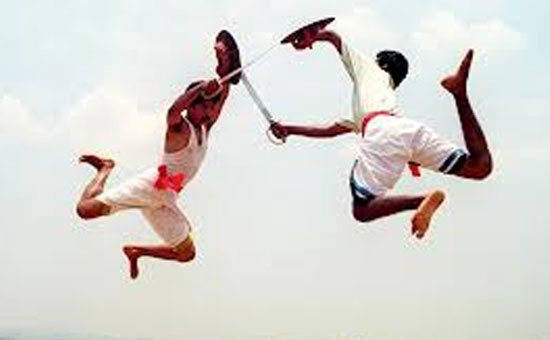 Kalaripayattu.
Kalaripayattu.
Kalaripayattu, one of the oldest
martial art forms in the world, originated in Kerala and is a matter of immense
pride for the Malayalis. The masters and practitioners of Kalaripayattu believe
that this art form is about 1500 years old.
Kalari is an ancient place of learning for subjects such as medicine, philosophy, architecture, astrology, geometry, and martial art. Kalaripayattu literally means the ‘art of fighting from the land of Kalari’ and conceptually means training in the art of combat.
The postures and exercises are
derived from the science of Yoga and medical treatments are derived from the
science of Ayurveda.
b. Parisa
Kali
 Parisa Kali.
Parisa Kali.
The Parisa Kali martial art form
involves rigorous physical training and knowledge of the use of arms or weapons.
It belongs to the North Malabar region of Kerala.
c. Velakali
Velakali martial art originated
in Travancore. Velakali performances portray the classic battle fought at
Kurukshetra between the warring cousins: Pandavas and Kauravas.
It involves enacting both an
overview of the entire battle and individual scenes from the epic battle,
detailing the concepts of right and wrong, and reinforcing good deeds over bad
deeds. Velakali is usually played out during temple festivals at Cherthala and
Amabalapuzha.
The spectacular show put up by
Velakali performers at the Shree Padmanabhaswamy temple at Thiruvananthapuram
during the ten day annual Painkuni temple festival, held in March-April, is
visually captivating.
d. Valeru
and Kundameru
Among the marital art forms of
Kerala, Valeru is unique. The art form, primarily concerned with using swords
as a means of combat, involves sword-throwing. Kundameru literally means
throwing spikes / spears and entails tightrope walking. It is performed at
temple festivals in Kerala during certain seasons only.
There are some lesser known martial art forms such as Njaninmel Kali which also consist of tightrope walking. However, this martial art form is gradually collapsing. Unique acts, postures, and formations from this martial art form are now being deployed in circus training in South India. In fact, the Kannur and Thalassery regions of Kerala are now known as the ‘home of circus in India.’
4. Literary
Arts and Cinema
Apart from the regular arts,
crafts, dance, music, and culture of the state, Kerala has a lot to offer in
terms of literature and cinema.
Literature
Malayalam poetry, prose, and
drama are appreciated the world over for their universal appeal despite their
local Dravidian flavours. Malayalam literature dating back almost 1000 years,
in addition to its own distinctive charm, has been influenced heavily by languages
such as Sanskrit, Arabic, English, French and Portuguese.
It is not surprising to note that
Kerala is home to production of not only Malayalam but also Tamil literature,
given the geographical proximity of the states and the descent of both languages
- Malayalam and Tamil.
Some of the noteworthy creations
in Malayalam include:
a. Ramacharitham
Poems composed during the first
600 years of Malayalam literature are called pattus. The Ramacharitham, composed by Cheeraman in 1198 CE, is a
compilation 1814 pattus - a collection of stories from the Yuddha Kanda in
Ramayana. While some experts argue about Ramacharitham being a Tamil verse, recent
research has established that the literary piece is in fact compiled in an
ancient style of Malayalam.
b. Manipravalam
Manipravalam, literally meaning
ruby coral, is a peculiar mixture of Malayalam (mani) and Sanskrit (pravalam).
It is widely considered literature of the elite, patronized especially the
Nambudiris. Some of the most renowned works belonging to the Manipravalam School
of literature include Vaisika Tantram, Achi Chiratams, and Sandesa Kavyas.
c. Niranam Poets
Madhava, Sankara, and Rama
Parrikar - three writers resumed and replenished the traditions of conventional,
serious-minded poetic craft set up by the Cheeraman of Ramacharitham.
Influenced by the Bhakti movement, the three writers wrote one of their most
important works - Kanassa Ramamyanam.
d. Champus and Krishnagatha
Two parallel schools of
literature emerged in the later 15th Century CE - the Champus (influenced by
Manipravalam) and Krishnagatha (influenced by pattus). While Champus were
essentially a combination of prose and verse, Krishnagatha is the song of
Krishna composed by the legendary poet by the sobriquet Cherusseri.
Cinema
Since the period of silent
Malayalam movies in 1928, the film industry in Kerala has struck a chord with
its audiences given their social orientation and relevance. The fourth biggest
film industry in India, Malayalam cinema goes by the sobriquet of Mollywood
(Malayalam + Hollywood).
Known for their realistic and content-driven plots, compelling storylines, and awe-inspiring cinematography, several old and new Malayalam movies have been shortlisted under the ‘Best Foreign Language Film’ category at the Academy Awards.
5. Kerala
Ayurveda
 An Ayurveda Centre.
An Ayurveda Centre.
Kerala extends to the world, the
gift of Ayurveda. Ayurveda is an ancient Vedic system of healthcare and
wellness that developed in India roughly about 5000 years ago. It is a science
of holistically treating the body, mind, and soul. Overall, Ayurveda is known
to offer healthy solutions or long-term treatment opportunities for almost all
the diseases experienced by humankind.
Hence, Ayurveda is known as the
Science of Life.
Kerala is the perfect place for the enrichment of Ayurveda owing to a tropical climate and a cool, soothing monsoon which lasts approximately 5 months, which in turn foster the growth of its rich, dense forests teeming with herbs and medicinal plants. Medically potent ingredients and oils are extracted from these medicinal plants and are offered to those who wish to avail of them – in different Ayurvedic treatment and massage plans and packages.
These treatment solutions and
massage therapies are verified and certified by medical authorities and are
offered by Ayurvedic centres across the state. Ayurvedic centres today combine
the practices of Ayurveda, Unani and Naturopathy to effectively formulate
customised packages for everyone.
It is incredible how Kerala has
retained, preserved, and enhanced this glorious tradition and ancient science
of Ayurveda.
The people of Kerala are
intelligent, warm, progressive, and hospitable to say the least. They
demonstrate immense respect for the wholesome essence of life.
To read similar articles about other states -
1. Maharashtra
2. Punjab
3. Rajasthan
Also read
1. Ayurveda
courses at the Sivananda Yog Ashram Kerala
2. Poomully Mana – Home to pristine Ayurvedic remedy
3. Sabarimala
is also connected to Tamil culture
4. The
all women festival in Kerala is Attukul Pongala
5. Kerala’s outstanding women